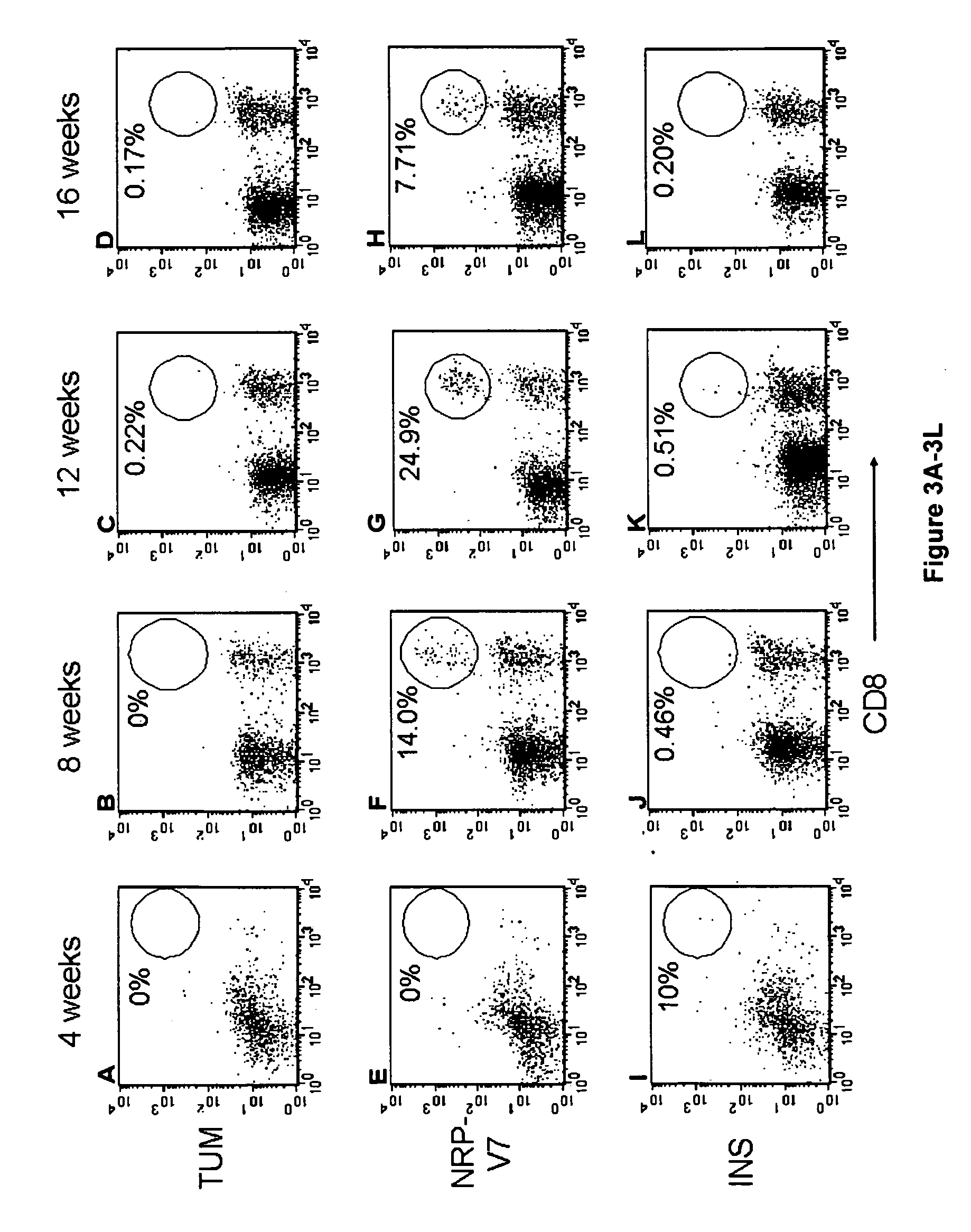Insulin epitopes for the treatment of type 1 diabetes
a type 1 diabetes and insulin epitope technology, applied in the field of autoimmune diseases, can solve the problems of diabetic coma or death, blindness, cardiovascular disease or kidney failure, diabetes, etc., and achieve the effect of reducing the life span of patients by a large amoun
- Summary
- Abstract
- Description
- Claims
- Application Information
AI Technical Summary
Benefits of technology
Problems solved by technology
Method used
Image
Examples
example 1
Autoreactive T Cells Recognise The TV1 Epitope
[0187] ELISPOT assays were performed to illustrate the effectiveness of various peptides as epitopes for diagnosis of diabetes. NOD spleen cells were assayed to determine the frequency of CTL that react to the murine IAPP precursor peptide mTV1 (KLPAVLLIL, SEQ ID NO:3). As shown in FIG. 1, an interferon-gamma ELISPOT assay was used to show that murine autoreactive T cells recognise mTV 1. Autoreactive T cells recognise in particular the peptide epitopes NRP-V7 (KYNKANVFL, SEQ ID NO: 13) and mTV 1. The peptide NRP-V7 was used as a positive control and is a previously described synthetic autoepitope (automimotope) of NOD mice (Amrani et al., 2000). NRP-V7 was not derived from any endogenous mammalian protein sequence but was identified by screening combinatorial peptide libraries. The peptide TUM was used as a negative control. TUM is derived from an endogenous tumour peptide not known to participate in type 1 diabetes but known to bind t...
example 2
Murine Antigen Presenting Cells Express MHC Class I Molecules On Their Cell Surface In Association With TV1 Peptide
[0188] FACS analysis was performed to quantify the percentage / proportion of antigen presenting cells (RMAS-Kd) that express stable MHC class I on their cell surface, in association with the TV1 peptide. RMAS-Kd is a transporter for antigen presentation (TAP)-deficient RMAS cell line transfected with the mouse MHC class I molecule, H-2Kd. Because the cell line is TAP deficient it cannot assemble MHC class I (in this case H-2Kd) complexes stably but requires surface stabilisation by exogenous peptides that can bind with the H-2Kd heavy chain and beta-2 microglobulin. The cell line was stained for MHC class I expression with or without TV1 peptide.
[0189] As shown in FIGS. 2A-H, a significant percentage of antigen presenting cells (RMAS-Kd) are able to express stably bound TV1 peptide in association with H-2Kd MHC class I on the cell surface. Where RMAS-Kd cells were incu...
example 3
Autoreactive Tetramer Positive T Cells Accumulate Within The Pancreatic Islets Of NOD Mice
[0191] Islets were isolated from the pancreatic tissue of NOD mice by injection of collagenase into the common bile duct. The pancreas was removed and incubated at 37° C. for ˜20 min to allow digestion of the exocrine tissue away from the islets. The islet fraction was separated by dextran gradient centrifugation and then the islets were hand-picked. Mice were grouped by age and the proportion of autoreactive T cells in the islets recognising the previously described autoepitopes, NRP-V7 and INSL or control peptide, TUM, in a complex with MHC class I tetramers, was determined.
[0192] FIGS. 3A-L show flow cytometry data demonstrating that autoreactive (tetramer-positive) T cells accumulate within the pancreatic islets of NOD mice as they age and develop clinical disease. FIG. 3M is a summary of the raw flow cytometry data shown in FIGS. 3A-L.
[0193]FIG. 4 is an example of the detection of autor...
PUM
| Property | Measurement | Unit |
|---|---|---|
| time | aaaaa | aaaaa |
| time | aaaaa | aaaaa |
| mass | aaaaa | aaaaa |
Abstract
Description
Claims
Application Information
 Login to View More
Login to View More - R&D
- Intellectual Property
- Life Sciences
- Materials
- Tech Scout
- Unparalleled Data Quality
- Higher Quality Content
- 60% Fewer Hallucinations
Browse by: Latest US Patents, China's latest patents, Technical Efficacy Thesaurus, Application Domain, Technology Topic, Popular Technical Reports.
© 2025 PatSnap. All rights reserved.Legal|Privacy policy|Modern Slavery Act Transparency Statement|Sitemap|About US| Contact US: help@patsnap.com



